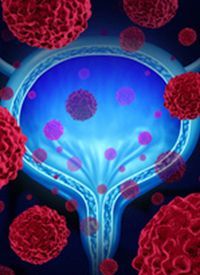Tislelizumab Plus Nab-Paclitaxel Elicits Responses in High-Risk, Non–Muscle Invasive Bladder Cancer
The addition of tislelizumab to nab-paclitaxel demonstrated efficacy and safety in patients with high-risk non–muscle invasive bladder cancer.

The addition of tislelizumab (BGB-A317) to nab-paclitaxel (Abraxane) demonstrated efficacy and safety in patients with high-risk non–muscle invasive bladder cancer (NMIBC), according to data from the phase 2 TRUCE-02 trial (NCT04730232) presented at the 2022 ASCO Annual Meeting.
At a median follow-up of 9 months (range, 3-16), findings showed that among efficacy-evaluable patients who received at least 3 cycles of treatment (n = 42), tislelizumab plus nab-paclitaxel achieved a complete response (CR) rate of 55% (95% CI, 43.6%-74.4%) and a partial response (PR) rate of 5% (95% CI, 1.6%-7.2%). The rate of patients who were not responsive to the combination was 40% (95% CI, 25.2%-54.8%).
Moreover, 66.67% of patients who received the doublet remained in a cystectomy-free condition, and the 12-month bladder intact disease-free survival rate was 62.68%.
“Tislelizumab with nab-paclitaxel represents a novel treatment option with a satisfactory benefit in treating NMIBC,” Zesheng An, MD, PhD, of Tianjin Medical University Second Hospital, said in a presentation of the data. “This therapeutic regimen showed acceptable immune-related adverse effects [irAEs], with grade 3 or 4 adverse effects [AEs] lower than 2%. [The combination] showed a promising prospect in bladder preservation.”
For patients with high-risk NMIBC who have multiple tumors with large invasion areas and cannot undergo resection, a radical cystectomy is the recommended clinical treatment. Although pembrolizumab (Keytruda) has demonstrated the efficacy and tolerability of immune checkpoint inhibitors in those with this disease per data from the phase 2 KEYNOTE-057 trial (NCT02625961), the role of a PD-1/PD-L1 inhibitor plus chemotherapy in this population had not been determined.
TRUCE-02 enrolled patients with histopathological confirmed high-risk NMIBC, or those with high-risk NMIBC as the major pathological component, defined as T1 tumors, high-grade Ta tumors, or carcinoma in situ. A multi-point resection of the bladder mucosa was required to show more than 2 areas, and more than 3 pathologies needed to be above histopathological diagnosis results. More than 2 senior clinical urologists were required to deem the tumor unresectable.
The most recent transurethral resection of bladder tumor needed to be performed within 6 weeks of trial enrollment, and tumor cells of urine exfoliation cytology were required to be visible within 2 weeks. Other inclusion criteria included having an ECOG performance status of 2 or less, acceptable bone marrow and hepatic function, and no contraindications to immunotherapy.
Once enrolled, all patients received 200 mg of intravenous (IV) tislelizumab plus 200 mg of IV nab-paclitaxel every 3 weeks for 3 to 4 cycles. Response assessments were conducted, and biomarker analyses were also completed on peripheral blood, urine, and tumor tissue.
The primary end point of the trial was CR rate, defined as the absence of NMIBC or progressive disease. Secondary end points included cystectomy-free survival, duration of response, and incidence of serious adverse effects (AEs) and irAEs.
Between July 2020 and January 2022, a total of 55 patients were enrolled to the trial, and all were considered to be evaluable for safety and efficacy. Forty-two patients received at least 3 cycles of both agents; 31 patients received 4 cycles and 11 patients received 3 cycles.
Additional data showed that the diagnostic efficacy of urine cytology was 68.42% (95% CI, 61.3%-75.6%). The diagnostic efficacy of urine fluorescence in situ hybridization was 45.71% (95% CI, 37.7%-53.4%).
A preliminary biomarker analysis showed that in 19 evaluable patients who had a CR or PR with the combination, 53% were PD-L1 positive. In non-responders (n = 10), half were PD-L1 positive. Additionally, in 13 responders, 69% were homologous recombination repair (HRR) wild-type disease, and 31% had HRR-mutated disease. In 4 non-responders, all had HRR wild-type disease.
“[The presence of] an HRR mutation may predict the prognosis of this treatment plan,” An noted. He that AR and TCF7L2 may be underlying markers that predict AE outcomes.
In all evaluable patients (n = 55), the most common grade 1/2 treatment-related AEs (TRAEs) included alopecia (81.82%), fatigue (43.64%), erythra (25.45%), pyrexia (23.64%), hypothyroidism (10.91%), aleucocytosis (7.27%), and pruritus (3.64%). Notably, no grade 5 AEs were reported.
Reference
Wang H, Hu H, Niu Y, et al. TRUCE-02: An open label, single-arm, phase II study of tislelizumab combined with nab-paclitaxel for high-risk non-muscle-invasive urothelial bladder carcinoma. J Clin Oncol. 2022;40(suppl 16):4507. doi:10.1200/JCO.2022.40.16_suppl.4507



